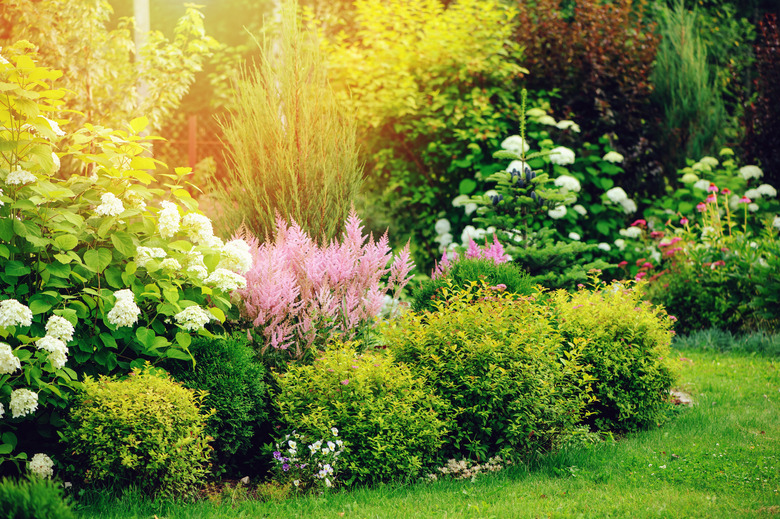How To Cure A Dying Shrub
We may receive a commission on purchases made from links.
Disease and insect infestations can be fatal to shrubs if they are not treated quickly. The right treatment varies, however, depending on the source of the problem. Determine what is causing the plant's symptoms before attempting to cure the dying shrub.
Symptoms and Causes
Symptoms and Causes
Deciduous, broadleaf evergreen and needle-leaved evergreens are generally susceptible to the same diseases and insect infestations and will develop similar symptoms. Wilting leaves, discolored yellow or brown leaves and dropping leaves are indications of many diseases and insect attacks. Discolored bark at the base of the stems and dead roots along with wilting leaves are likely due to root or crown rots. Chewed, discolored or speckled and wilting leaves are due to insect infestations. Yellow leaves are commonly caused by chlorosis.
Rotten Shrub Roots
Rotten Shrub Roots
Root and crown rots are caused by a pathogen that flourishes in wet soil. A shrub may become infected while the weather is cool and rainy but usually does not show symptoms until it is stressed. This is often fatal for the shrub. Fast action is necessary to cure the dying shrub. Pull the soil away from the base of the stems and upper roots. Place fresh soil over the roots after the stems and upper roots dry out.
Water the shrub until the soil is wet to a depth of 1 to 2 feet, then allow the soil to dry before watering it again to prevent rot. Apply the water over the root zone below the outer edge of the branches rather than near the stems.
Pesky Insect Pests
Pesky Insect Pests
Shrubs will usually recover from insect infestations on their own. However, repeated attacks and defoliation will debilitate the shrub, and some insects can kill it.
- Check the leaves for insects and honeydew. Honeydew is a clear, sticky substance that aphids and many other insects secrete. Insecticidal soap will kill most types of harmful insects.
- Prune out severely infested branches and dispose of them in the garbage. Disinfect the pruners with household rubbing alchol before and after using them but wipe the rubbing alcohol off with a rag before pruning the shrub.
- Mix 5 tablespoons of insecticidal soap into 1 gallon of water, pour it into a sprayer and spray the shrub thoroughly.
- Coat the tops and bottoms of the leaves as well as the stems. Apply the insecticidal soap early in the morning or in the evening and wash it off the shrub with clear water one to two hours after spraying.
- Repeat the treatment one week later if the insects return.
Poor Plant Nutrition
Poor Plant Nutrition
Shrubs are often susceptible to iron chlorosis, which causes the leaf tissue between the veins to become yellow. Mild chlorosis can be caused by a variety of conditions such as unusual weather, and the shrub will commonly recover on its own. If the leaves and branches are dying, however, treatment will be necessary to cure the dying shrub.
- Test the soil pH to determine if it is between 6.0 and 6.5, which is ideal for most shrubs. If it is above 6.5, many shrubs are unable to absorb iron and other nutrients from the soil, even when they are present.
- Make a 4-inch-deep trench with a hoe 1 to 2 feet away from the shrub stems.
- Combine equal parts of elemental sulfur and ferrous sulfate. Pour the combination into the trench to a depth of 1 inch and cover it with soil. This will adjust the soil pH and provide additional iron for the dying shrub.
References
- University of Minnesota: SULIS: Trees and Shrubs: Diseases, Insects and Other Problems
- University of California Agriculture & Natural Resources: UC IPM Online: Pests in Gardens and Landscapes: Phytophthora Root and Crown Rot in the Garden
- The University of Arizona Cooperative Extension: Watering Trees and Shrubs
- Missouri Botanical Garden: Soap Products
- University of California Agriculture & Natural Resources: UC IPM Online: Pests in Gardens and Landscapes: Scales
- University of California Agriculture & Natural Resources: UC IPM Online: Pests in Gardens and Landscapes: Aphids
- Washington State University, Puyallup Research and Extension Center: The Myth of Cloroxed Clippers
- Missouri Botanical Garden: Iron Chlorosis
- Utah State University Extension: Forestry: Preventing and Treating Iron Chlorosis in Trees and Shrubs
